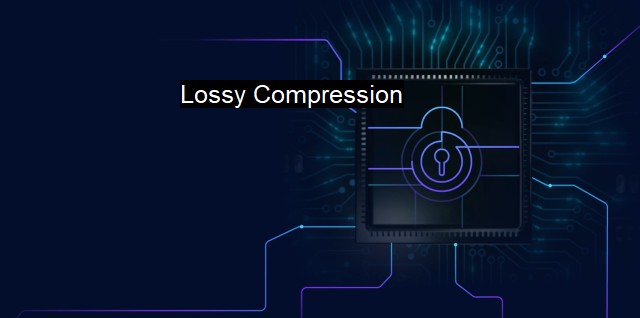What is Lossy Compression?
Understanding Lossy Compression: Reducing Data while Compromising Quality for Efficient Digital Media Transmission and Storage
Lossy compression is a method utilized in data encoding that facilitates the reduction of file size, where the elimination or modification of redundant data results in the discharge of some data components. The term "lossy" draws implication from this aspect - certain amount of data is "lost" during the compression process. Although lossy compression results in reduced quality, the impact is typically minimal, to the extent that the compressed data - when compared to the original form - still appears relatively identical for the user.Lossy compression may have both benefits and drawbacks. On a positive note, its ability to reduce file sizes can streamline data transfer and conserve storage space, thereby enhancing system performance. In cyber defense systems such as antivirus software, this mechanism can enhance the ability to handle and scan large quantities of data more swiftly and efficiently.
Lossy compression reduces network usage for vast data sets, thus mitigating the risk of network congestion and potential vulnerabilities linked to such scenarios. This is particularly crucial in environments where networks are consistently deployed for data transfer, as massive data flow requires substantial bandwidth. Hence, lossy compression can be vital in maintaining the efficiency and security of these systems.
There is a downside to this method. The most prominent issue is potential data degradation following repeated compression and decompression. In cybersecurity terms, the loss of information can have serious repercussions. For instance, during forensic analysis, every bit of data matters. Every byte lost could contain crucial evidence or indications pertinent to a cybersecurity breach.
Lossy compression might affect the efficacy of antivirus software. Modern Antivirus works by matching patterns; if a file matches a particular behavioral or signature pattern of a known malicious entity, it is flagged as a threat. Thus, the accuracy and reliability of pattern-matching algorithms greatly depend on the quality of data. After compression through a lossy algorithm, a file may get deformed to the point where it no longer matches the pattern of its original, uncompressed version. Therefore, a problematic file that has been compressed and decompressed may be erroneously recognized as benign by antivirus software, potentially culminating in high-value security risks.
There's another concerning aspect of lossy compression related to cybersecurity is the issue of steganography. Adversaries occasionally hide malicious data within ‘carrier’ files using steganography. These carriers, frequently image, audio or video files, may themselves undergo lossy compression at some point, leading to the loss of hidden data. Consequently, this process aids the transmission of undetected threats within compressed files. The wide adoption of lossy compression standards like MP3 for audio and JPEG for images makes it a notable concern relating to cyber threats.
Despite these potential issues, the judicious use of lossy compression can still offer significant benefits in the realm of cybersecurity. As a tool, it can be leveraged to enhance network speed, improve storage efficiency and increase overall system performance. As with all cybersecurity tools and strategies, the key to harnessing lossy compression’s benefits while mitigating its risks lies in vigilant system monitoring and continuous risk assessment and management. Therefore, security architects must carefully balance usability, security, and performance when deploying lossy compression.

Lossy Compression FAQs
What is lossy compression in the context of cybersecurity and antivirus?
Lossy compression is a method used to reduce the size of files by discarding some of the data. This method is commonly used in antivirus software to compress virus signature databases and reduce their footprint on the system. However, the downside of lossy compression is that it can sometimes lead to a loss of data or information, which can affect the performance of the antivirus.How does lossy compression work in antivirus software?
Antivirus software uses lossy compression to reduce the size of virus signature databases, which store information about known viruses. This helps to reduce the memory and storage requirements of the antivirus software, which in turn improves its performance. The lossy compression algorithm used by antivirus software discards some of the data that is not considered essential, while retaining the most important information.What are the benefits of using lossy compression in antivirus software?
The main benefit of using lossy compression in antivirus software is that it reduces the size of the virus signature database, which improves the performance of the antivirus. This enables the software to scan files and detect viruses more quickly and efficiently. Additionally, the reduced size of the database means that it takes up less storage space on the system.Are there any risks associated with using lossy compression in antivirus software?
The main risk associated with using lossy compression in antivirus software is that it can lead to a loss of data or information. This can affect the accuracy of virus detection and increase the risk of false positives or false negatives. Additionally, some malware may be designed to exploit weaknesses in the lossy compression algorithm used by the antivirus software, which can compromise the security of the system. Therefore, it is important to use lossy compression carefully and to monitor the performance of the antivirus software regularly.| | A | | | B | | | C | | | D | | | E | | | F | | | G | | | H | | | I | | | J | | | K | | | L | | | M | |
| | N | | | O | | | P | | | Q | | | R | | | S | | | T | | | U | | | V | | | W | | | X | | | Y | | | Z | |
| | 1 | | | 2 | | | 3 | | | 4 | | | 7 | | | 8 | | |||||||